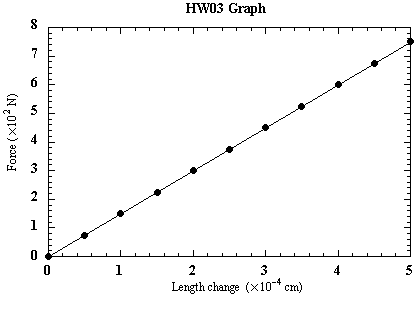
Hooke’s law: F=kx , Vectors: magnitude cannot be negative; sign (+/–) is the direction.
Chapter 2, Problems 20-25 (also Chapter 3 Problems 1-15 and Chapter 4, Problems 2-7)

Figure for problems 20 and 21.
20. The compression force vectors, magnitude, C , generated by the top and bottom of the frame are drawn above.
21. To balance, the tension T and the compression C are related by :
C = –C , T = +T , (left side force vectors)
2C + 3T = 0
2(–C)+3(T) = 0,
C = (3/2)T .

Figure for problems 22 and 23.
22. The tension force vectors, magnitude T, generated by each spring are drawn above.
23. The relationship between the value of C, and the value of T, that will balance is:
C = –C, T = +T, (left side force vectors)
C + 4T = 0
(–C) + (4T) = 0 ,
C = 4T

24. The tension vectors acting in each section of the belt are drawn on the figure above.
25 The relationship between the tension, T , and compression ,C, is, C = 2T , and the vectors are drawn to agree with this.
C = +C, T = –T, (right side force vectors)
2C + 4T = 0
2(+C) + 4(–T) = 0 ,
C = 2T
*Ch. 3, Problems 1-15
1. Which force, electromagnetic(E), gravitational(G), weak nuclear(WN) or strong nuclear(SN), is primarily responsible for the following: (all correct for credit)
| fusion of Deuterium and Tritium. SN | pumping water from a well. E |
| smoking a cigarette E | beta decay of Tritium to Helium-3. WN |
| bleaching a shirt. E | sawing wood. E |
| cutting a piece of paper. E | toasting a muffin. E |
| cooking a chicken. E | defrosting in a microwave oven. E |
| crushing a nut. E | growing of hair. E |
2. True or False (all correct for credit)
T F Two force vectors are "equal" only if the magnitude and direction are the same.
T F Two force vectors can "balance" if the magnitude and direction are the same.
T F Two force vectors cannot "balance" and be "equal" at the same time.
T F Two force vectors with "equal" magnitudes can point in opposite directions.
T F Two force vectors cannot stretch an object if they are "equal".
3. The pressure 1´105 N/m2 is equal to 14 lb./in.2
![]()
4. The units of a spring constant are force/distance .
5. Attach the graph requested on a separate sheet of paper. (below)

6. A long spring obeys Hooke’s law and can be stretched 10 cm by a force of 20 N.
a) The slope (with units) of a plot of the force vs. the stretch of
this spring is 2 N/cm
b) If the force is 50 N the stretch of the spring is , x
= F/k = (50 N)/(2 N/cm)= 25 cm
7. The spring constant k of the spring in the region shown is, k = 5 N/cm.
k = slope = (DF/ Dx) = (70 - 60 N)/(12 - 10 cm) = 5 N/cm
8. The force when the spring just begins to stretch, F0 = 10 N
F0 = F - kx = (70 N) – (5 N/cm)(12 cm) = 10 N
9. 1 N of force is equal to 0.22 lb. of force (about 1/4 lb.)
10. A spring stretches 7 cm by a force of 21 N. The spring constant is 3 N/cm
11. The maximum force I apply to dental floss in use is about 5 lb, or 20 N.
12. An additional 10 N of force increases the stretch of a spring from 5 cm to 7 cm.
a) The spring constant, k = 5 N/cm and
b) 15 N of force will stretch it another 3cm.
k = slope = (DF/ Dx) = (10 N)/(2 cm) = 5 N/cm ; F = kx = (5 N/cm)(3 cm) = 15 N
13. A rod with k = 2´107 N/m compresses 0.1 mm under a force of 2´103 N.
x = F/k = (2´103 N)/( 2´107 N/m) = 1´10-4 m (103 mm/ 1 m) = 0.1 mm
14. The mass (in kg) of 1 m3 of lead is 1.1´104 kg
density = (11g/ cm3 ) = (11g/ cm3 )(1 kg/1000 g)(100 cm/1m) 3 = 1.1´104 kg/m3
15. The mass of one cubic meter of water is 1.0 ´103 kg
density = (1g/ cm3 ) = (1g/ cm3 )(1 kg/1000 g)(100 cm/1m) 3 = 1.0 ´103 kg/m3
*Ch. 4, Problems 2-7
2. If , F1 = +A, F2 = +3A, F3 = -2A, and F4, balance, then F4 = – 2A
F1 + F2 + F3 + F4 = 0 ; F4 = –(F1 + F2 + F3 ) = –(+A +3A+(–2A)) = – 2A
3. The tension at the middle of the rope is also 50 N
4. 5 springs (each, k) will make a new spring constant five times stronger, k' = 5k
Draw the springs:

5. A single spring (k) can be cut in half and each piece is a spring twice as strong.
6. Four springs connected as shown make a longer spring with the same spring constant.
![]()
7. Complete this sentence: springs generate forces and store energy.
Back to Homework List